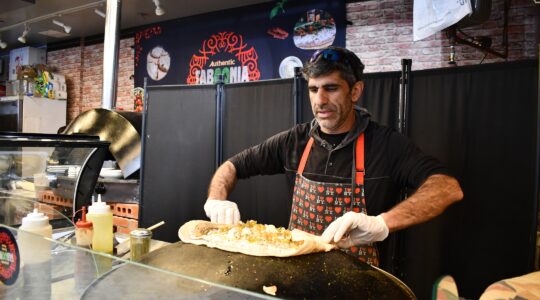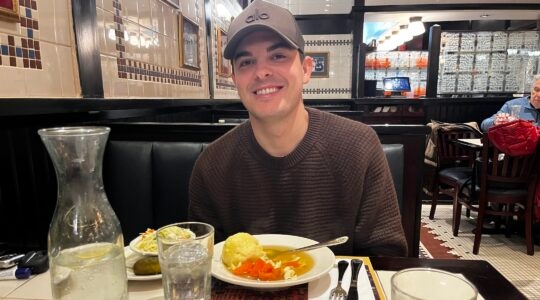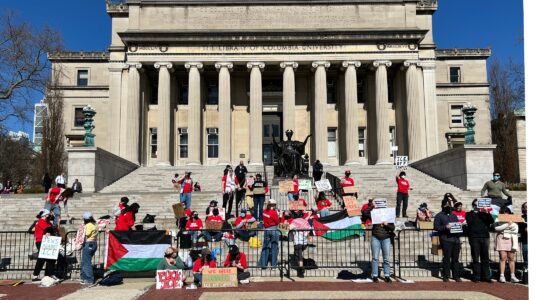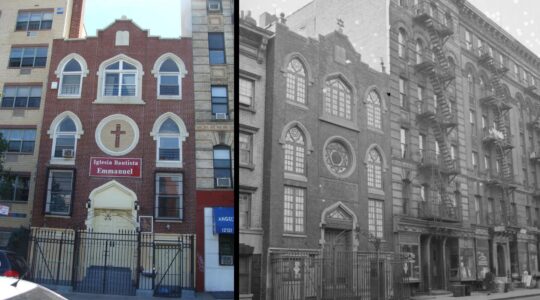With the strains of a violin concerto playing in the background, spectators took in the artwork hung on the crisp white walls of the gallery. All in all, a rather average Sunday evening gallery opening on the Lower East Side.
But this was not just any gallery. It was the newly renovated women’s gallery of the Stanton Street Shul, a synagogue founded more than a century ago, with a membership that dwindled but that suddenly is growing and a group of long-time Lower East Side residents dedicated to keeping it alive.
“We’ve been around for a hundred years and we want to be around for another hundred years,” Rabbi Aviad Bodner, spiritual leader of the synagogue since 2014, told The Jewish Week. He is at the helm of a new project to restore the entire building. Members credit Rabbi Bodner with helping grow the synagogue, which has seen its membership jump from about 30 units when he was hired to 115 this year.
The art show currently on display in the synagogue is the second show to be hosted in the gallery, which, now that the women’s section is located on the first floor in a more modern location beside the men’s section, serves as an art gallery and event space. The creative use of space is characteristic of the synagogue, a hub for Jewish artists in the neighborhood once known as the landing point for Jewish immigrants and now home to hipsters and boutique clothing stores and coffee shops.
“The idea of art in the synagogue, it’s always been here,” said David Wander, an artist and longtime member of the synagogue who curated the current exhibition. “It’s always been connected to the synagogue because there have always been so many artists who are connected to the synagogue.” To illustrate the point, the show was called “The Stanton 11,” and featured a number of artists who are shul members.
Art has long been at the physical heart of the synagogue, too. At the center of the building renovation project is the restoration of the synagogue’s zodiac paintings, or mazalot in Hebrew, that adorn the walls of the sanctuary on the main floor. After decades of leaks and deterioration, the paintings, made in the 1930s and symbolic of the 12 months of the Jewish calendar, were fading and chipped. Before the restorations began, several artists painted their own interpretations of the zodiacs on canvases which now hang in the basement of the synagogue, and many of those artists have been involved in restoring the zodiacs on the sanctuary walls.
Built in 1914 on a tenement lot — the building measures 20 feet across and 100 feet long — the synagogue is home to a congregation founded 20 years earlier in another Lower East Side location by Jewish immigrants from Galicia, now part of Poland and Ukraine. As the Jewish community eventually migrated from the Lower East Side to the Bronx and Brooklyn, the community dwindled and the building fell into disrepair. But a small group of longtime residents of the neighborhood — and some more recent transplants — have kept the synagogue going through the years.
This is not the first time a group of dedicated members have saved the small synagogue from destruction. In 2004, the synagogue’s then-rabbi tried to sell the synagogue building without informing the congregants, who then sued the rabbi to block the sale. The court ruled in their favor and the synagogue survived.
“It’s terrific. I think it’s great that this congregation is growing and that it’s surviving on the Lower East Side; everything else is not,” said Norman Borden, a photographer who shot the building for a book about the neighborhood’s synagogues, “Synagogues of New York’s Lower East Side,” by Dr. Gerard Wolfe in 2012. He returned to the synagogue for the opening of the gallery exhibit on Sunday. “It’s nice that this is one of the few remaining pieces of the Lower East Side that’s maybe going to be here for a while.”
Jeff Katz, a board member of the synagogue, decided to take on the renovation project full-time after Beth Hamedrash Hagadol, another Lower East Side synagogue across the street from his apartment, burned down in 2017.
“One summer evening the sky turned red; I was on my balcony and that was the fire. I saw it burn to the ground,” said Katz. “I said to myself, this is not going to happen to the Stanton Street Shul.”
The initial work was funded by a surprise gift the synagogue had received a few years earlier from an older couple who had frequented the synagogue. When they died, unbeknownst to anyone else, they left the synagogue $150,000. “That was the seed money,” said Paul Ruffer, the shul president, who hopes the upcoming gala diner in March, where Katz will be honored, will raise enough money to begin renovating the basement.
Having retired from his work as a college administrator, Katz dedicated himself to the project full-time, enlisting an architect and a contractor to oversee the renovation. They began with the exterior of the building, securing the walls (“The north wall was moving north,” said Katz) and repairing the roof. All of the light fixtures in the building were rewired to address the fire hazard. “It was really a tinderbox,” said Katz. The walls were repaired and painted, the hardwood floor in the sanctuary was ripped up and new hardwood installed, and all the marble plaques and signs throughout the building were cleaned and their lettering repainted. New upholstered pews will be installed in the next few weeks.
Where a wooden slab existed for decades, a circular stained-glass window was installed in the north wall a few weeks ago. It replaced, after many decades, a window that was smashed in a break-in during the 1950s. More biblically symbolic, the break-in left the marble tablets, displayed above the ark beneath the stained glass window, broken in half.
Just a few weeks ago, the tablets were reinstalled above the ark, glued back together, the marble cleaned and the gold letters repainted, going a long way towards restoring the synagogue to its former glory.
Looking at the art along the gallery walls, overlooking the newly restored tablets and zodiacs, and surrounded by artists and guests at Sunday’s opening of the art show, Ruffer reveled in the growing crowd filling the gallery.
“It’s a miracle — it’s a series of miracles,” he said. “You can’t appreciate it if you didn’t see it before.”
This is one of a two-part series on the Lower East Side. Click here to read about this nonagenarian artist who is remembering the neighborhood through drawing.
The New York Jewish Week brings you the stories behind the headlines, keeping you connected to Jewish life in New York. Help sustain the reporting you trust by donating today.




